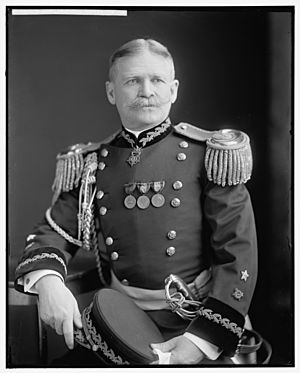Ernest Albert Garlington facts for kids
Quick facts for kids
Ernest Albert Garlington
|
|
|---|---|
 |
|
| Born | February 20, 1853 Newberry, South Carolina, US |
| Died | October 16, 1934 (aged 81) San Diego, California, US |
| Place of burial | |
| Allegiance | |
| Service/ |
|
| Years of service | 1876–1917 |
| Rank | |
| Service number | 0-13110 |
| Unit | 7th Cavalry Regiment |
| Battles/wars | Indian Wars Wounded Knee Creek Spanish–American War Philippine–American War |
| Awards | Medal of Honor |
| Other work | Inspector General of the Army; member, General Staff of the Army (1906-17) |
Ernest Albert Garlington (born February 20, 1853 – died October 16, 1934) was an important U.S. Army general. He earned the Medal of Honor, a very brave award, during the Indian Wars. He also served in the Spanish–American War and the Philippine–American War.
Contents
Early Life and Education
Ernest Albert Garlington was born in Newberry, South Carolina. His father, Albert Creswell Garlington, was also a general in the South Carolina militia during the American Civil War.
In 1869, Ernest started studying at the University of Georgia (UGA). However, he left UGA early to join the United States Military Academy (West Point). This is a famous school for training army officers.
He graduated from West Point in 1876. On June 15, he became a second lieutenant in the 7th Regiment of the United States Cavalry. He joined his unit after the Battle of the Little Bighorn, which happened a few weeks after he was appointed.
Military Career Highlights
Starting in the Army
Because his regiment had many losses, Garlington was quickly promoted. He became a first lieutenant on June 25, 1876. He then served as the Regimental Adjutant, helping with the regiment's daily tasks, until 1881.
In 1883, he led one of the groups trying to rescue Adolphus Greely's expedition. This was a difficult mission to find explorers in the Arctic.
Bravery at Wounded Knee
On December 29, 1890, Garlington was injured at Wounded Knee Creek in South Dakota. For his great bravery there, he received the Medal of Honor on September 23, 1893. This is the highest award for military heroism.
Serving as Inspector General
Garlington continued to rise through the ranks. He became a captain in 1891 and a major in 1895. He then became an inspector general. This job meant he checked on how the army was doing and made sure rules were followed.
In 1898, Garlington served as inspector general in Cuba during the Spanish–American War. He took part in the Battle of Santiago de Cuba. That same year, he was promoted to lieutenant colonel.
From 1899 to 1901, he was inspector general in the Philippines during the Philippine–American War. He was promoted to colonel in 1901. He returned to the Philippines as inspector general from 1905 to 1906.
Becoming a General
On October 1, 1906, Garlington reached the rank of brigadier general. He became the Inspector General of the Army and served on the General Staff of the Army. This meant he helped plan important army operations.
In 1908, he led the army's investigation into the Brownsville affair. This was a complex event involving African American soldiers. In 1911, he traveled to Germany to observe their army's training exercises.
Later Years and Legacy
Ernest Albert Garlington retired from the army on February 20, 1917, because of his age. However, he continued to serve in the office of the Chief of Staff for several months during World War I.
He passed away on October 16, 1934. He was buried at Arlington National Cemetery in Arlington, Virginia. His first wife, Anna Buford Garlington, and their daughter, Sally Garlington Chamberlin, are buried with him. His son, Cresswell Garlington, also became a brigadier general in the U.S. Army.
Garlington also wrote two books: Historical Sketches of the Seventh Cavalry Regiment and A Catechism on Cavalry Outposts, Reconnaissance, Patrols, and Advance and Rear Guards. These books helped teach soldiers about cavalry tactics.
Awards
- Medal of Honor
- Indian Campaign Medal
- Spanish Campaign Medal
- Philippine Campaign Medal

